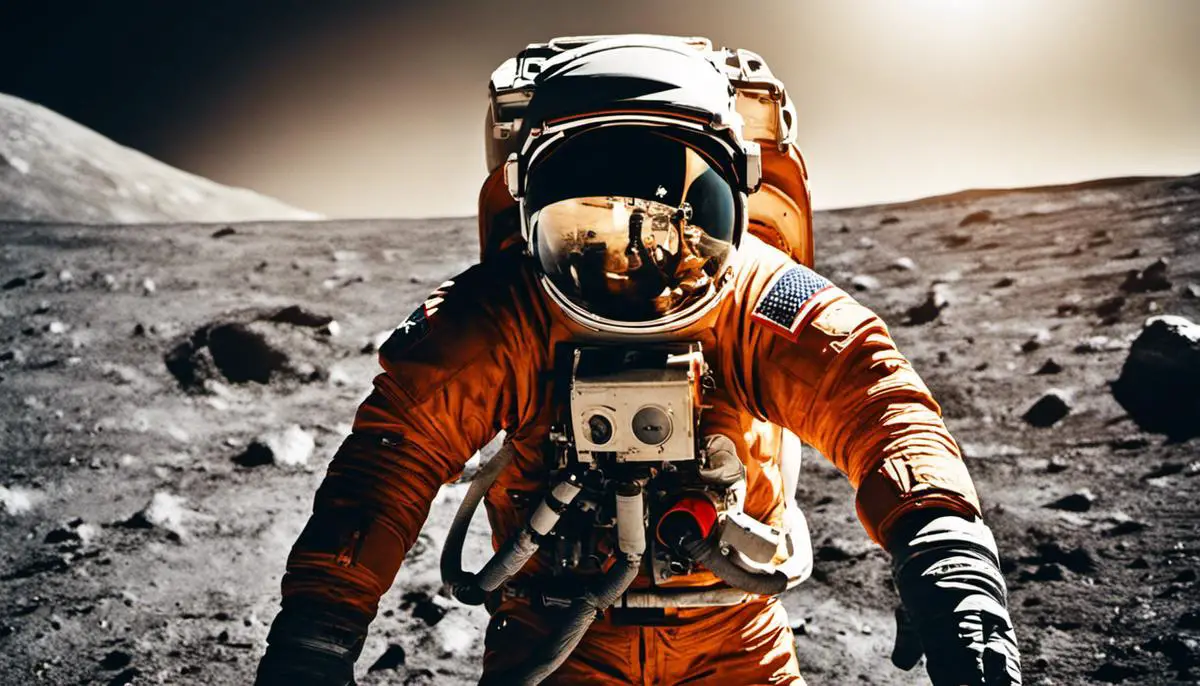In a riveting era marked by rapid scientific evolution and geopolitical rivalry, humankind embarked upon what can be deemed as the most ambitious plunge into the unknown – the Apollo missions. The unfolding narrative of these extraordinary endeavors is inseparable from the intensely competing contexts of the Cold War rivalry between the United States and the Soviet Union. The fascinating groundwork for these missions was laid by unparalleled advancements in rocket engineering, nourished by the visions of scientists and enabled by strategic maneuvering. Our expedition into their historical lattice will touch upon these dynamic intersections, shedding light on their execution, and the cascade of scientific and technological triumphs they spurred.
Contents
Prelude to the Apollo Missions
Geopolitical and Scientific Factors Fueling the Inception of the Apollo Missions
As we delve into the annals of space exploration history, one epoch-making event stands out: the Apollo Missions. These missions, undertaken by NASA during the 1960s and 1970s, forever transformed our comprehension of the universe, and earthly life itself. To fully appreciate this remarkable endeavor, it becomes essential to dissect the tangle of geopolitical pressures and scientific influences that shaped the commencement of the Apollo missions.
To commence, the geopolitical climate of the mid-twentieth century played an imperative role. Amidst the throes of the Cold War, a silent battle for global supremacy was fiercely fought between two superpowers: the United States and the Soviet Union. Space exploration, in this context, emerged as a pivotal battleground. In October 1957, the Soviet Union launched Sputnik 1, the first artificial satellite, escalating the stakes in the realm of space exploration – a development remembered as the ‘Sputnik shock’. This ignited a fierce competition referred to as the ‘Space Race’ – contributing immensely to the initiation of the Apollo missions.
The American government, driven by national pride and security concerns, accelerated its investment in NASA and committed to ‘landing a man on the moon and returning him safely to Earth’. The Apollo program became a symbolic manifestation of America’s technological and ideological superiority, brandishing its position in the international playground.
On the scientific front, numerous enthralling factors intertwined with this high-stakes geopolitical landscape. Amid the escalating space race, technological advancements were accelerating at a blistering pace. The foundations established by German engineer Wernher von Braun brought rocket technology within reach, catalyzing NASA’s ambitious lunar aspirations.
Simultaneously, astrophysics and satellite technology provided pivotal inputs. By 1958, Project Vanguard, an American satellite program, provided invaluable data about the Earth’s structure and shape. Building upon this, the Mariner 2 mission in 1962 offered rudimentary understandings of Venus, revealing stark differences between Earth and its celestial neighbors.
Such astronomical discoveries extorted a paradigm shift in our cosmic perspective, melding with the intensifying geopolitical competition to give birth to the Apollo missions. These missions aimed to push the bounds of human understanding, elevating us to unprecedented cosmic territories.
Moreover, exploring celestial bodies like the Moon provided immense potential for revealing the secrets of our universe. The lunar surface, hailed as a ‘Rosetta Stone’ of planetary science, held encrypted clues to unfathomable cosmic mysteries including the early history of Earth and the Solar System’s evolution.
Therefore, the merger of geopolitics with rapid scientific progress spearheaded the dawn of a new era symbolized by the Apollo missions. The potent cocktail of a high-stakes international competition compounded with revolutionary scientific breakthroughs stimulated the pursuit of an exceedingly ambitious and uncharted path: sending humans to the Moon. Within the framework of this expansive narrative, it becomes clear how the reciprocation between science and politics fueled the inception and perpetuation of mankind’s most audacious exploratory ventures. The legacy of these missions continues to echo in the corridors of space exploration and planetary science, underscoring the powerful interplay between earthly conflict and human ingenuity.

Execution of the Apollo Missions
The specific planning and execution of the Apollo missions constitutes a veritable masterclass in operational management and technological innovation. Beginning with the selection of astronauts to participate in these historic missions, meticulous attention was dedicated to the physical and psychological composition of potential crew members. These attributes had to marry perfectly with individual mission goals, underlining the intensity of planning associated with such endeavors.
The training spanned years, ingraining astronaut candidates with technical, physiological, and operational knowledge and skillsets required for their lunar travel and exploration. Vast ranges of spacecraft systems, survival training, and even lunar geology were components of a comprehensive curriculum designed to prepare the astronauts for the myriad of scenarios they could potentially encounter.
The Saturn V rocket, a towering symbol of the Apollo missions, was developed to deliver these ambitious lunar voyagers to their destination. Incorporating three stages, each with multiple engines, the Saturn V was an engineering marvel unparalleled at the time of its creation. Its launch process required precise timing and coordination across different phases: first-stage ignition and lift-off, in-flight engine cutoff and separation, followed by activation of ensuing stages – each milestone bringing the astronauts one step closer to the moon.
The Lunar Module was another critical element in this vast construction. A two-stage vehicle, this piece of technological ingenuity would safely descend astronauts to the moon’s surface and subsequently re-launch them into lunar orbit to reunite with the Apollo command module.
Substantial obstacles emerged along the path towards these historical lunar explorations. The Apollo 1 mission, notoriously ended in catastrophe during a launch pad test, tragically killing all three crew members aboard. This grim reminder of the inherent dangers of space travel compelled an extensive review of safety measures, and resulted in a seismic shift towards safer practices and materials in spacecraft assembly, while underlining the palpable risk involved in these ambitious efforts.
The Apollo 13 mission presented another prominent challenge: an oxygen tank failure during transit to the moon. The expertise of the astronauts, coupled with the problem-solving acumen of scientists and engineers on the ground, averted disaster and brought the team safely back to Earth. This incident underscored the outstanding importance of contingency planning and the necessity of rapid responses to crises that arise during space travel.
Countless technical complications arose during the planning and execution of the Apollo missions, ranging from fuel cell malfunctions to position adjustment inefficiencies. Such hitches necessitated novel solutions and adaptive resilience, both from the crew in space and the support teams on Earth, creating a continuous environment of learning and adaptation.
The Apollo missions encapsulate an extraordinary chapter in humanity’s cumulative pursuit of knowledge and exploration. Their planning and execution remains a testament to the heights humanity can reach when ambitiously driven by the thirst for exploration and understanding. This understanding, coupled with the courage to face and overcome the myriad of unexpected challenges encountered along this cosmic journey, does not only attest to the impressive achievements of the Apollo missions, but also serves as a rallying call to seize future opportunities. Challenges and setbacks, be they monumental or miniscule, are but stepping stones on humanity’s journey to comprehend and master the universe that surrounds us.

Scientific Discoveries and Technological Advancements
Now let us deeper delve into the staggering contributions that the Apollo missions ushered in, not only burgeoning our scientific knowledge and technological inventory, but also propelling us into a new frontier of human discovery and innovation.
Undoubtedly, one of the most significant and enduring legacies of these explorations has pivoted around the myriad of technological innovations that have since revolutionized our daily lives. Epitomizing this synergy between astronomical journey and technological innovation is the miniaturization of electronic components that were necessitated by the space constraints in the Apollo spacecraft. Communications technology also reached unprecedented heights as the Apollo missions necessitated innovations in high speed data transmission, advanced fiber optics, and satellite communications.
Yet the influence was not constrained to technological advancements. The scientific revelations gained throughout the Apollo missions were equally groundbreaking. The Apollo missions were responsible for fostering a deeper comprehension of our celestial neighbor, the moon. Through sophisticated seismometers placed by astronauts during Apollo 11 and Apollo 12 missions, researchers were provided with crucial insights into lunar seismic activity. The surprising nature of moonquakes, and the intriguingly ‘ringing’ quality of the moon, only served to catalyze further research and study.
Not only did the Apollo missions provide impressions of the lunar body, but they also brought back tangible, physical knowledge – the lunar rocks. The return of lunar rocks opened an entirely unexplored avenue of scientific exploration. The lunar samples showcased an astonishing similarity to terrestrial basalts and endorsed the provocative theory that the moon was indeed a part of our earth, dislodged through a violent cosmic event in the early throes of our solar system’s formation.
Arguably, one of the most iconic technological innovations linked to the Apollo missions is the Consolidated Lunar Atlas. This comprehensive photographic record of the lunar surface continues to be an invaluable research tool, assisting researchers around the globe in their detailed scrutiny of the moon.
Additionally, computer technology, an essential facet of contemporary life, was monumentally impacted by the Apollo missions. The complex navigational demands of the moon voyage signified an imperative for an onboard flight computer, thus leading to the development of the Apollo Guidance Computer. This marked a pivotal turnaround in the evolution of computer technology, catalyzing the development towards smaller, faster and more reliable computers.
Through the lens of the Apollo missions, it is evident that boundaries of knowledge and innovation are only as restrictive as we allow them to be. The Apollo missions have left an unparalleled scientific and technological legacy, thus proving to be a testament of an impassioned human spirit that constantly seeks to stretch beyond the known horizon.

Legacy of the Apollo Missions
The Apollo missions, undertaken by the National Aeronautics and Space Administration (NASA) between 1961 and 1972, left an indelible footprint on the landscape of American society, deeply seeped into the collective consciousness, thereby engendering a vital perceived global leadership in space exploration.
The Apollo program was a watershed moment in history, inciting a nationwide surge in scientific curiosity and public interest in space exploration. Post the successful completion of the Apollo 11 mission, there was a sharp upswing in students seeking careers in science, technology, engineering, and mathematics (STEM). This “Apollo effect” facilitated an unprecedented explosion of innovation, significantly invigorating the United States’ scientific and technological prowess.
The economic ripples of the Apollo missions were manifold, yielding distinct and substantial impacts in contemporary engineering, technology, and related industries. This transformative era bred groundbreaking advances in multiple sectors ranging from materials science and life support systems to telecommunications.
For instance, the development of heat-resistant materials for re-entry vehicles triggered advancements in diverse fields such as nuclear power and firefighting equipment. Furthermore, miniaturization of electronic components and data processing technologies, an imperative outcome of the Apollo program, armed the industries with compact, efficient systems paving the way to the information age we dwell in today.
The Apollo missions not only reshaped our understanding of space but also catalyzed the dawn of international collaborations in space exploration. The joint Apollo-Soyuz Test Project in 1975 marked the end of the Space Race and laid the foundation for subsequent international ventures like the International Space Station (ISS).
Moreover, the Apollo expeditions delve into the intriguing lunar frontier, undeniably broadened our comprehension of the Earth-Moon system. The analysis of lunar rocks, understanding of lunar seismic activity, and development of the Consolidated Lunar Atlas, significantly enhanced our knowledge of lunar, and thus, terrestrial geology.
Evidently, scientific findings from the Apollo program embedded lunar exploration in the overarching narrative of the solar system and human existence evolution. The conceptual shift invoked by the stunning Apollo Images of the Earth, viewed from the cosmic perspective, nurtured the inception of the environmental movement and heightened public consciousness about Earth’s vulnerability.
Finally, the Apollo missions’ve forever altered the trajectory of American society, affirming its reach beyond terrestrial boundaries, and inspiring countless future space explorations and endeavors. The audacious odyssey to land a man on the moon, but merely a decade into the space age, was a testament to human innovation and willpower. It signaled the inception of an era where the sky was no longer the limit, etching the essence of the Apollo legacy into the heart of human exploration.

As the echoes of the Apollo missions reverberate in the annals of human accomplishment, their legacy stands not just as testament to an audacious journey, but also as a beacon guiding future explorations. The missions monumentalized America’s global standing and induced a seismic shift in the national ethos. Concurrently, they instigated a renaissance in space exploration globally, and fundamentally restructured our perception of Earth’s celestial neighborhood. As we peer into the horizon of the unfolding space age, the Apollo missions continue to inspire, serving as an epitome of endeavor, innovation, and fraternity. It is through our collective memory of these ventures and their enduring lessons of international collaboration that we continue to envision and strive for the unchartered territories of the cosmos.

With a passion for unraveling the mysteries of the moon, Dr. Luna Sterling is a highly-respected astrophysicist, a dedicated lunar enthusiast, and a captivating blogger. After earning her Ph.D. in Astrophysics from the Massachusetts Institute of Technology (MIT), she served as a lead scientist and mission planner for NASA, contributing significantly to various lunar missions.
For over two decades, Luna has been at the forefront of lunar science, pushing boundaries and pioneering discoveries that have enriched our understanding of the moon’s geological history. However, it’s her infectious enthusiasm for all things lunar that truly sets her apart.
In an endeavor to bring the moon closer to everyone, Luna started her blog, “Luna’s Lens: A Closer Look at the Moon.” With this platform, she offers a unique blend of intriguing moon facts, updates on lunar missions, and personal anecdotes from her experiences in the field, all told in an engaging and accessible manner.
Luna’s unique blend of scientific expertise and warm, humorous writing style has transformed complex astrophysics into compelling narratives that captivate her audience. As a gifted communicator, she leverages her knowledge and experience to relate scientific facts to everyday life, thus making her blog a must-read for both seasoned space enthusiasts and curious newcomers.
Interactive and inviting, Luna frequently encourages reader engagement through thought-provoking discussions and a monthly ‘Ask Dr. Luna’ feature, where she personally answers questions about the moon and space exploration. A celestial storyteller at heart, Dr. Luna Sterling’s passion for the moon is as vast as the cosmos she explores, making her an invaluable beacon in the world of lunar science.
